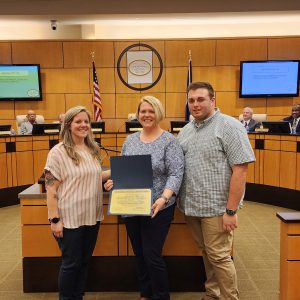July 16, 2024
City Councils Proclaim Stroke Smart Waynesboro and Stroke Smart Staunton
Waynesboro and Staunton join the Stroke Smart Virginia initiative, partnering with public health officials for life-saving stroke education efforts
(Staunton, Va.) – The City of Waynesboro and the City of Staunton in partnership with the Central Shenandoah EMS Council and the Virginia Department of Health’s (VDH) Office of Emergency Medical Services (OEMS), recently committed to supporting stroke education through the Stroke Smart Virginia initiative.
Stroke Smart Virginia is a public health initiative to reduce pre-hospital delays and increase timely stroke treatment through simple education and actions. This life-saving initiative also was joined in partnership with the Central Shenandoah Health District, Augusta Health, Waynesboro First Aid Crew and Waynesboro Emergency Management’s fire and EMS personnel and Staunton Augusta County First Aid & Rescue Squad, Inc.
Local government officials and city dignitaries from the Waynesboro and Staunton City Councils presented Stroke Smart proclamations to the Central Shenandoah EMS Council and Regional Office of EMS during two separate city council meetings held on June 24 and June 27. Members of the Waynesboro City Council shared their personal stories of the impact of stroke and pledged their support to improving the lives of the people of Waynesboro. The City of Staunton local government shared their passion to promote public education about stroke recognition and emergency care. Both localities join this initiative and commitment to partner with public health professionals for a “Stroke Smart” city.
“This special initiative connects public health advocates who are committed to a collaborative effort to educate people on the signs and symptoms of stroke and the importance of calling 911,” said Director Daniel Linkins, Central Shenandoah EMS Council. “Patients experiencing common stroke symptoms, including facial droop, arm weakness, slurred speech or confusion, need the right care quickly. EMS providers are trained to recognize the signs of stroke and perform additional tests to determine the best facility to treat specific types of stroke.”
“Stroke awareness, to include prevention, recognition and access to early treatment is not just a healthcare responsibility, it is the responsibility of the entire community,” said Gary Critzer, State Board of Health Chair, Central Shenandoah EMS Council President and City of Waynesboro Director of Emergency Management and EMS. “The Central Shenandoah EMS Council, in cooperation with VDH, local governments, first responder agencies, 911 centers and area hospitals, is working to improve stroke awareness in our communities. Increasing awareness improves early recognition of stroke symptoms and access to appropriate care. Early access to care at a stroke ready hospital is critical to reducing disability and death.”
Waynesboro and Staunton are the second and third cities in Western Virginia to join the Stroke Smart Initiative, and the first and second cities in the Central Shenandoah EMS Region and Health District to demonstrate a commitment to lead efforts that support the VDH’s vision to become the healthiest state in the nation and mission to protect the health and promote the well-being of all people in Virginia.
For more information about the Stroke Smart initiative in Virginia, visit www.vdh.virginia.gov/stroke/stroke-smart-virginia/. For more information about the Central Shenandoah EMS Council, Inc., visit www.csems.org/.


